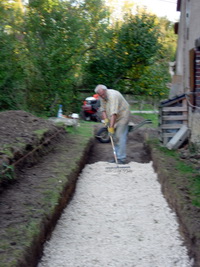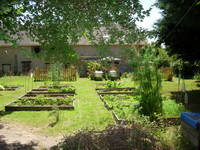
|
The
garden, covering 5000 m2 (0.5 hectares
or 1¼ acres), lies mostly to the front of the house, which faces
south. It has been laid out in four styles.
Paths lead to and
through various environments. Wildlife and plants are generally encouraged
by attempting to provide different habitats, and by not using chemical
products. The principles of organic gardening are respected as far
as possible.
The
garden is not
particularly child friendly i.e. there are things that
can; attach to, cut, drop on, prick and/or sting you and certainly nothing
should be eaten without knowing that it is safe.
[The
Soil Association] [Garden
Organic] [Garden
Organic]
[Royal Horticultural Society (RHS)] [Association
Kokopelli] [Association
Kokopelli]
[Agriculture
biologique] [Le
bio (Organic Farming)] [Le
bio (Organic Farming)] 
|
| 1 — Formal |
2 — Less
formal |
3 — Wild |
4 — Vegetables |
|
|
- Fish pond
- Decking
- Lawn
- Helicoidal herb
garden*
- Front terrace
- Japanese garden
(including small fish pond)
* Herb
Gardening by Robert Sulzberger
ISBN 10:
0947793704 — ISBN 13: 9780947793708.
|
- Tent pitches
- Circle of silver
birch
- Fruit walk
- Grassed areas
- Heart garden
- Shrubs
|
- Bog garden
- Shaded woodland
- Lake
- Teepee
- Long grass
- Peripheral walk
- Weather stone
- Hedge window
|
- Raised beds
- Greenhouse (polytunnel)
- Composting
- Fertiliser brewing
|
Formal
(near the house)
- At the front
is the lawn (an
artificial environment if ever there was one), laid down a few
years ago after lengthy preparation with sandy topsoil brought
locally from near Tannerre*.
This worked well, but with a policy of no chemical weedkillers
or fertilisers (I am prepared to make an exception here but P is
not), the whole thing now needs a re-seed or a re-think. A camomile or
thyme lawn, perhaps. The lawn can be used as a tent pitch (The
Queen's Pitch).
- Moving anticlockwise
around the house, outside the kitchen door are a small terrace
and a helicoidal herb garden*.
- Next to the
paved area is the decking beside
the fish pond. The decking sits snugly under a male holly tree,
apparently the biggest in the village, which gives dappled shade
in summer and protects the pond from the heat of the afternoon.
The decking leads around to a small raised perennial bed and a
tent pitch (The King's Pitch).
- The 7000-litre
(1500-gall UK) fish pond contains different types of goldfish (carp and orfe),
comets, shubunkins and golden orfe. The pond is serviced by mechanical,
biological and ultra-violet filters with the addition of aeration
pumps in the summer to keep the oxygen levels up. As a result of
the clean water, the carp breed well but the orfe have not done
so yet. The pond has attracted many other life forms including
frogs and dragonflies.
- Before the decking
the path turns round the side of the house with another raised
border for vegetables and flowers to the right.
- The path continues
along the back of the house with a rough section seeded with wild
flowers alongside. At this point the path is separated from the
garden by a retaining wall of railway sleepers.
- Near the back
door is the Japanese-influenced area, laid out with white gravel
and a 1500-litre (330-gall UK) square fish pond, a rill and
cascades, all of which can be illuminated at night. The whole area
has been set out with plants that have Japanese sounding names.
There is space for a yoga mat and table and chairs here.
- Just outside
the back door is a small covered wooden terrace, used for eating
out of the heat of the midday sun.
- The path continues
anticlockwise along the west side of the house
to the garage and workshop.
Back
to
* Tannerre more
info.
|
 
The house (south face) and
helicoidal herb garden

The decking

A raised border
The
back path 

The Japanese influenced garden
|

The drive
|
Less
formal (further away)
- At the front,
across the main drive, are some larger plants, roses and shrubs,
arranged roughly in the form of a heart. This garden will eventually
be planted with more aromatic and tactile plants.
- Further out,
a circle of silver birches and box enclose a hammock space. The
hammock will brush against mints and lavenders as it sways in the
mottled shade of the birches.
- To the right
is the BBQ and campfire area.
- To the left
is some rough-cut grass and another tent pitch (The Knight's Pitch).
- Further to the
left, near the gate, is a patch of blackthorn which
produces sloes for gin. The blackthorn thicket may be developed
into a maze or a retreat.
- Along the drive
stand a large cherry tree and walnut trees. We harvest the fruits
of both, leaving enough for the birds and red
squirrels.
- The curved
'fruit path' from the gate to the birches forms a boundary between
the less formal and wilder areas. The fruit is mainly soft fruit,
currants, peaches and apricots, although some of these will need
to be replanted. The peaches and apricots will be trained into
an espalier or
cordon hedge. Raspberries did not like the hot and dry conditions
here.
Back
to
|
Wild
(nature takes the upper hand)
- Behind the circle
of silver birch is a path leading to a large unlined 600,000-litre
lake (132,000-gall (one million pints) UK). This was to be a reservoir.
A mechanical wind pump would lift water to a water tower' enabling
the garden to be watered using a gravity feed. The lake was dug
into the natural earth which appears to be clay. So far it has
failed to fill up, but has retained water through several summers,
even the 2009 drought.
- The soil dug
out to create the lake was used to build a ridge, which has been
planted with willows and plums, and spring bulbs visible from the
house.
- Behind the bank
is a small wooded area with a path running through it.
- To the right
this shady path leads alongside the neighbouring property and back
via the bog garden to the campfire/BBQ area.
- To the left
the path leads through a 'dell' and on to the teepee, another place
to hang a hammock. In the hedge at the south-eastern end of the
garden is a small stile leading to the road.
- Returning to
the house, you can either :-
- walk along
a path cut through the blackthorn, straight past the 'window'
in the hedge and the 'weather
stone', and back to the drive, or
- return
via a patch of long grass, where a log cabin is planned on
the left, to the filter pond. Turning to the left takes you
to a bridge and back to the birches.
- Between the
bridge and the birches there are plans for a semi-covered stage
for entertaining and events.
- Various bird
boxes have been built and placed in the wild area but as yet they
seem uninhabited. The surrounding countryside must offer them plenty
of other choices.
Back
to
|
. Wild
flowers Wild
flowers
Weather
stone 
 The
hedge window The
hedge window
A
wooded path 
 The
teepee The
teepee
 The
weatherstone The
weatherstone
The
stile 
|

A selection of vegetables
from the garden
The
veg plots 
Composting
and polytunnel 
|
Vegetables
(behind the house)
- We grow vegetables
in a series of raised beds measuring 2.4 x 1.2 m (8' x 4').
- Behind these
plots are the composting bins for kitchen waste, leaves and some
grass clippings. This is also where nettle fertiliser and the like
are brewed and matured.
- Beyond the compost
area is a stile to the road leading to the hamlet of Les Creux.
This is the northern edge of the garden.
- The hedge bordering
our property and other hedges across the road help
protect L'Echiquier from
the winter northeasterlies.
- Next to the
raised beds is the polytunnel, used for seed germination and for
growing tomatoes, cucumbers, peppers and so on.
- The vegetable
garden area is being enclosed to diminish damage by chickens and
sheep who may lose their way there. It appears, however, that moles
are not subject to these rules.
- A.M.A.P.P. In
July 2009 we joined the 'Association pour le Maintien d'une
Agriculture Paysanne de Proximité - Les paniers bio de Saint
Privé', a co-op of local food producers and buyers
in our village.
Back
to
|
